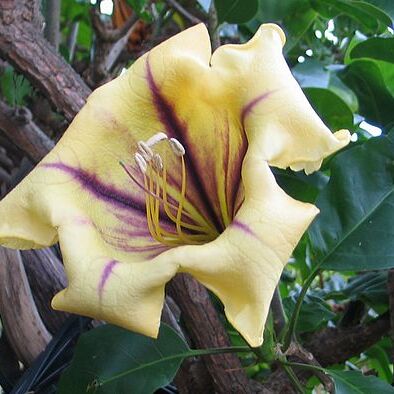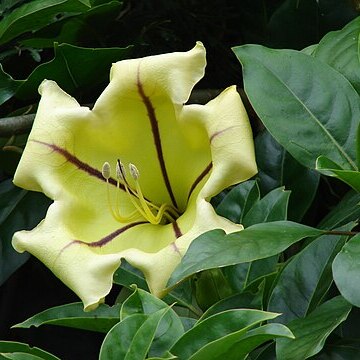Scandent shrubs, high-climbing hemi-epiphytes or large stemmed lianas, unarmed; stems mostly glabrous, stout, to 5 cm across, with no apparent pith, the bark flaking; twigs stout with a large pith. Leaves simple, entire, membranaceous, coriaceous or somewhat succulent, glabrous or variously pubescent with simple or dendritic hairs, sometimes with minute glandular trichomes or excrescences; minor leaves mostly wanting. Inflorescence a 1-or few-flowered cluster at the ends of twigs or short shoots, pedicels stout, rarely elongate, leaving an expanded cicatrix on the twig. Flowers with the calyces mostly tubular, but sometimes ellipsoidal or campanulate, angled and sometimes inflated, splitting in flower into 2-5 irregular lobes, splitting almost to the base in fruit, pubescent or not; corolla imbricate and the apex flattened or broadly rounded in bud, often very large, fleshy and mostly glabrous, campanulate, craterform or funnelform, often slightly zygomorphic, the lobes entire to fimbriate and often recurved; stamens 5, equal (unequal in bud)34 mostly exserted, filaments inserted at the base of the tube, often pubescent at the point of insertion, straight or gently curved in the upper portion; anthers fabiform, 4-loculed, not apiculate, dehiscing longitudinally and the thecae walls reversing 90 to become elliptical, ovary conical, sometimes apically flattened, partly or mostly immersed in the receptacle, and thus partly inferior and in a perigynous disc or nectary, 4-loculed, perhaps becoming partly 2-loculed, ovules many, the style sometimes much exceeding the anthers and
More
Scandent shrubs or woody lianes, glabrous or pubescent. Leaves alternate; lamina entire, ± coriaceous. Flowers solitary, terminal, large, bisexual, slightly zygomorphic. Calyx usually tubular, irregularly 2–5-lobed, not enlarged in fruit. Corolla funnel-or cup-shaped or salverform, 5-lobed, imbricate in bud, entire or usually fimbriate. Stamens 5, ± equal, included or exserted; base of filaments hairy; anthers dehiscing by longitudinal slits. Ovary 4-locular, partially inferior; stigma slightly 2-lobed. Fruit a leathery, conical berry. Seeds numerous, reniform, flattened.
persistent for a time on the fruit. Fruit a leathery berry, loosely enclosed by the ruptured calyx; seeds many, reniform.
Several species are in cultivation as ornamentals mostly in tropical and subtropical gardens; see Ellison (1999: 502–503), Cullen et al. (eds) (2000), Spencer (2002: 123).


